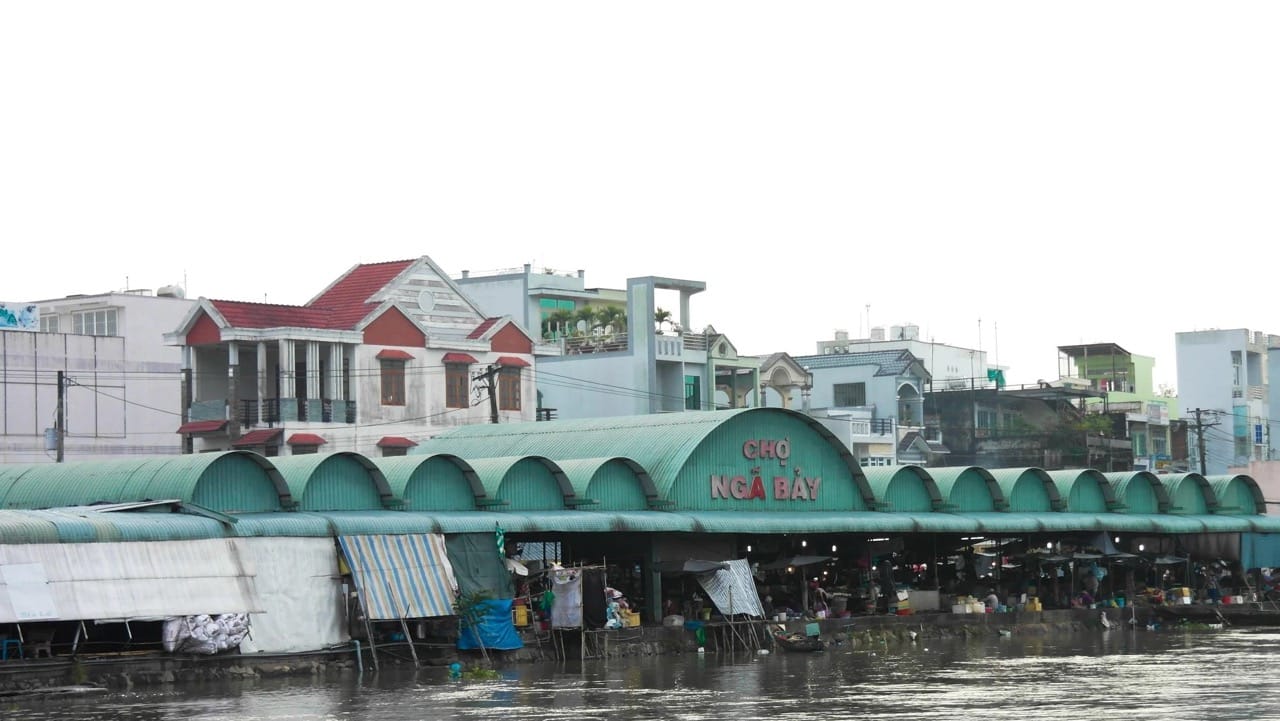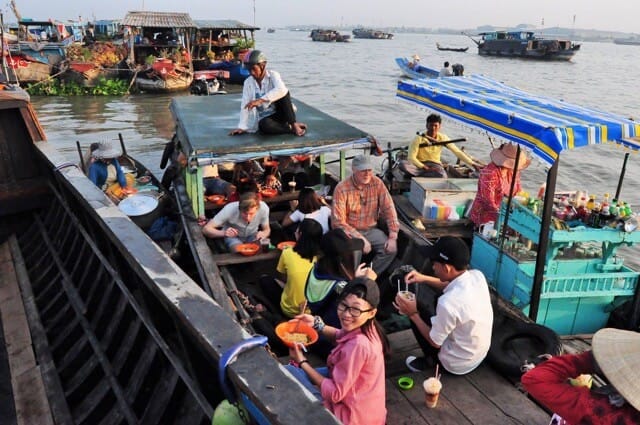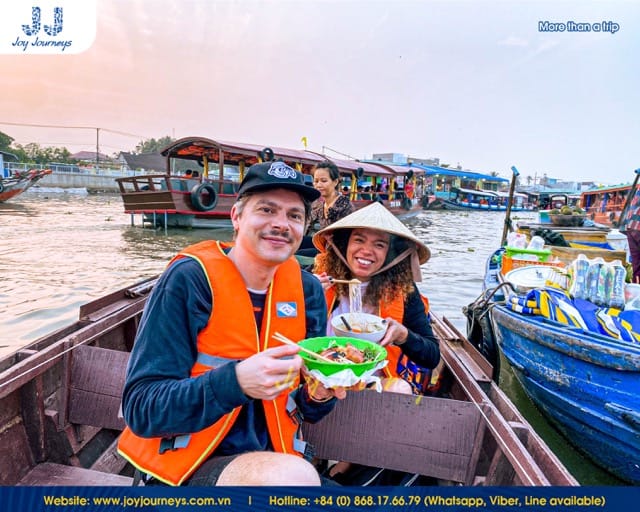Floating market Vietnam, particularly in the southwest, epitomize the country’s rich cultural heritage. These bustling hubs of trade and tradition have thrived for generations, serving as vital centers of commerce along the waterways. Iconic markets like Cai Rang, Cai Be, and Long Xuyen offer visitors an immersive glimpse into Vietnamese riverine life, with vibrant displays of goods and local culture. In this article, we explore the allure and significance of these floating markets, inviting readers to discover the enchanting spirit of Vietnam’s waterborne traditions.
Contents
Exploring Famous Floating Market Vietnam
Exploring the famous floating markets of Vietnam is an unforgettable experience. From the bustling Cai Be to the picturesque Cai Rang, and the vibrant Can Tho, these markets are a unique blend of shopping, cuisine, and culture all in one. The floating markets of Vietnam are a must-visit for anyone looking for an authentic cultural experience.
Cai Rang Floating Market
The Cai Rang Floating Market in Vietnam is the largest of its kind in the Mekong Delta, offering visitors a unique glimpse into the region’s vibrant culture and bustling trade scene. This market is a hub of activity, where vendors and buyers navigate the waterways on their boats to trade goods and interact with each other.
The market is renowned for its diverse selection of products, including local specialties like rice vermicelli and hu tieu noodles and fresh fruits and vegetables. Vendors use their boats to display their goods, and buyers can easily navigate the waterways by boat to find what they are looking for. The atmosphere is alive with the sound of negotiations and laughter, making it a truly unforgettable experience.
Apart from the trading scene, the Cai Rang Floating Market also offers a glimpse into the rich history and culture of the region. Visitors can learn about the development of the market, the business practices of the vendors and buyers, and the unique culinary traditions and way of life of the local people.
Recognized as a national intangible cultural heritage site since 2016, this bustling market is renowned for its wholesale trading of fruits, agricultural products, and vegetables sourced from the fertile lands of the region. Originally established as a prominent rice purchasing hub for overseas Chinese, Cai Rang Floating Market has evolved into a bustling marketplace that operates primarily in the early hours of the morning, starting as early as 2 to 3 am.
Visiting Cai Rang Floating Market offers travelers a unique and immersive experience, allowing them to witness the vibrant spectacle of riverine commerce in action. As the market springs to life in the early hours of the morning, visitors can immerse themselves in the bustling atmosphere, observing the rhythmic dance of trade as boats navigate the waterways. Witnessing the daily rituals of merchant families, who have made their homes on boats for generations, provides a fascinating glimpse into the traditional way of life in the Mekong Delta.
Beyond the trading activities, Cai Rang Floating Market offers visitors the opportunity to sample local delicacies and immerse themselves in the cultural tapestry of the region. From savoring freshly prepared dishes at floating eateries to exploring nearby attractions such as traditional villages and scenic waterways, there’s no shortage of experiences to delight the senses.
Nga Bay Floating Market
Nga Bay floating market, also known as Phung Hiep floating market, stands as a timeless testament to the vibrant trading culture of the Mekong Delta. With a history spanning over a century, this market has been a focal point of commerce and community since its formation around 1915, following extensive canal digging efforts.
Situated at the convergence of seven rivers – Cai Con, Mang Ca, Bung Tau, Soc Trang, Xeo Mon, Lai Hieu, and Xeo Vong – Nga Bay Floating Market boasts a unique geographical setting that contributes to its allure. Along the banks of these rivers, numerous craft villages have emerged, specializing in boat building, weaving, farming, and other traditional trades. This convergence of river branches has created a captivating mosaic of cultures and livelihoods, making Nga Bay Floating Market a must-visit destination for travelers seeking an authentic glimpse into the West.

Visitors to Nga Bay Floating Market are greeted by a bustling scene of activity, particularly during the early morning hours. From 5 to 8 am, the market reaches its peak as local farmers and traders gather to buy and sell a diverse array of fresh agricultural products. Throughout the day, the market continues to operate, offering visitors ample opportunities to explore its offerings and soak in the lively ambiance.
One of the highlights of Nga Bay Floating Market is its extensive selection of fruits, which vary according to the season. As visitors navigate the bustling waterways, they are treated to a colorful display of boats brimming with ripe fruits, providing insight into the region’s agricultural cycles and bounty.
Exploring Nga Bay Floating Market offers travelers a multifaceted experience, allowing them to not only engage in trade but also immerse themselves in the rich cultural tapestry of the Mekong Delta. Each river branch presents a unique opportunity to discover specialized craft villages and traditional practices, adding depth and diversity to the overall experience.
Nga Nam Floating Market
Nga Nam floating market, nestled in the quaint town of Nga Nam approximately 60 kilometers from Soc Trang city, offers travelers a captivating glimpse into the vibrant river life of Vietnam’s Western region. Immersed in the bustling ambiance of this floating market, visitors can experience the rich cultural heritage and unique trading traditions that define life along the Mekong Delta.
To embark on a journey to Nga Nam floating market, travelers can start from the center of Soc Trang city and follow National Highway 1A towards Phu Loc. From there, a turn onto Provincial Road 42 will lead visitors directly to the market’s bustling waters. Nga Nam Floating Market typically opens early in the morning and continues until around 8 o’clock, although the busiest time is often between 5 am to 6 am. During this period, the river wharf comes alive with the sights and sounds of hundreds of boats congregating, creating a vibrant and bustling atmosphere that is truly unforgettable.

As one of the highlights of the region, Nga Nam floating market experiences heightened activity near the Lunar New Year, with trading activities extending from morning till night. This festive period adds an extra layer of excitement to the market, drawing visitors from far and wide to partake in the celebrations and immerse themselves in the local culture.
While the improved road transportation system has led some traders to adopt onshore market setups, Nga Nam floating market still retains its bustling charm, serving as a beacon of the Western floating market tradition. Despite modernization, the market continues to exude the authentic soul of river life, offering travelers an authentic and immersive experience that is not to be missed during a visit to Soc Trang.
Long Xuyen Floating Market
Long Xuyen Floating Market is one of the most unique and fascinating markets in the Mekong Delta region of Vietnam. Located in the heart of An Giang province, this market offers visitors a glimpse into the vibrant trading scene of the region and the local way of life.

The market is situated on the Hau River, and it is accessible by boat or by road. The market is especially busy in the early morning, when vendors and buyers come together to trade goods and interact. Visitors can witness the market’s lively atmosphere, with the sound of negotiations and laughter filling the air.
Long Xuyen Floating Market is renowned for its diverse selection of products, including fresh fruits and vegetables, seafood, and handicrafts. Vendors use their boats to display their goods, and buyers can easily navigate the waterways by boat to find what they are looking for.
In addition to the trading scene, visitors can also enjoy other activities such as boat tours and sampling local street food. The nearby attractions include the historic Thoai Ngoc Hau Tomb and the peaceful Ong Ho Island.
In addition to the floating market culture in the Mekong Delta, when you come to Ho Chi Minh City, you can experience other famous markets here, which are all popular tourist destinations such as:
- Bến Thành Market: Located in the center of Ho Chi Minh City, this market is famous as a place for foreigners, but you need to know some tips to fully experience it when you come here.
- Cho lon: Although it is called a market, it is not a traditional market. It is a famous old area in Ho Chi Minh City in the past. See more
Planning Your Floating Market Tour from Ho Chi Minh City
Embarking on a journey from the vibrant streets of Ho Chi Minh City to the enchanting floating markets of the Mekong Delta promises an adventure filled with cultural discovery and culinary delights. As you plan your excursion, it’s essential to consider various factors such as distance, travel options, and recommended tour packages to ensure a smooth and enjoyable trip.
Distance and Travel Options
The distance between Ho Chi Minh City and the renowned Cai Rang Floating Market in Can Tho is approximately 170 kilometers (106 miles) southwest. While this may seem like a considerable distance, the journey is easily manageable, offering travelers the opportunity to explore the picturesque landscapes of the Mekong Delta along the way.
Ho Chi Minh City to Cai Rang Floating Market: The Route and Transportation
Traveling from Ho Chi Minh City to Cai Rang Floating Market typically involves a combination of road and water transportation. One popular route takes travelers from Ho Chi Minh City to Can Tho, the largest city in the Mekong Delta region, by bus or private car. From Can Tho, visitors can embark on a scenic boat ride along the Can Tho River, which takes approximately 30 minutes to reach Ninh Kieu Wharf, the gateway to Cai Rang Floating Market.
For those seeking a more convenient and hassle-free option, guided tour packages are available, offering round-trip transportation from Ho Chi Minh City to Cai Rang Floating Market. These tours often include comfortable transportation, guided tours of the market, and opportunities to explore nearby attractions, providing travelers with a worry-free experience.
Duration and Costs
The duration of the journey from Ho Chi Minh City to Cai Rang Floating Market can vary depending on the chosen mode of transportation and itinerary. On average, the journey by bus or private car takes approximately four to six hours each way, allowing for ample time to explore the market and its surroundings.
As for costs, bus tickets from Ho Chi Minh City to Can Tho typically range from $5 to $15 USD per person, depending on the type of bus and amenities provided. Boat trips from Ninh Kieu Wharf to Cai Rang Floating Market may cost around $5 to $20 USD per person, depending on the duration and type of boat.
Recommended Tour Packages
For travelers seeking convenience and peace of mind, guided tour packages from Ho Chi Minh City to Cai Rang Floating Market are highly recommended. These tour packages typically span over 2 days, allowing ample time to fully experience the bustling market atmosphere, particularly during the early morning peak hours of 6-7 a.m. This timing ensures visitors witness the vibrant trade activities at their peak.
Included in these comprehensive tour packages are round-trip transportation, guided tours of the market, and opportunities to explore nearby attractions such as Ninh Kieu Wharf and the bustling streets of Can Tho city center. Additionally, to enhance the overall experience, accommodations at a nearby resort are often included in the package, ensuring travelers can rest and rejuvenate after a day of exploration.
Prices for these tour packages typically range from $100 to $150 USD per person, depending on the duration, inclusions, and the quality of accommodations provided. While these packages may require a higher investment, they offer convenience, comfort, and the assurance of a worry-free journey, making them an attractive option for those seeking an immersive and memorable experience at Cai Rang Floating Market.
Sampling local cuisine
Vietnam’s floating markets beckon food enthusiasts and travelers seeking an authentic cultural immersion. From the bustling Cai Be market to the vibrant Cai Rang market and the charming Long Xuyen market, each destination offers a tantalizing glimpse into local life.
Famous for their abundance of fresh produce, these markets boast an array of exotic fruits such as mangoes, longans, and durians, tantalizing visitors with their vibrant colors and enticing aromas. In addition to fruit, the markets are renowned for serving up hot breakfast delights. Visitors can savor the iconic banh mi, a crispy French-style baguette filled with savory delights like grilled pork, pate, pickled vegetables, and fresh herbs. Com tam, or broken rice, is another beloved dish featuring grilled pork, a fried egg, and assorted vegetables atop a bed of fragrant broken rice.

For the adventurous palate, the floating markets offer a plethora of unique flavors and delicacies. Dive into the pungent allure of durian, a spiky fruit that ignites the senses with its potent aroma and rich, creamy texture. With its diverse culinary offerings and vibrant ambiance, Vietnam’s floating markets promise an unforgettable gastronomic adventure for all who visit.
When you travel to Vietnam, you should definitely experience the night markets in different provinces and cities from North to South. Each place has its own unique culture, but all of them will offer wonderful experiences for tourists.
See more: Top 10 Vietnam Night Markets
Conclusion
In conclusion, Vietnam’s floating markets offer an unforgettable journey into the country’s rich culture. From the vibrant marketplaces of Cai Be, Cai Rang, and Long Xuyen to the preservation efforts and cultural significance, visitors are guaranteed an immersive experience. Armed with these tips, travelers can confidently explore these markets and delve into the heart of Vietnamese tradition. Embark on this unique adventure and discover the captivating culture of Vietnam for yourself.
Frequently Asked Questions
Which is the best floating market in Vietnam?
Determining the “best” floating market in Vietnam is subjective, as each market offers its own unique charm and attractions. However, Cai Rang Floating Market in Can Tho is widely regarded as one of the largest and most iconic floating markets in the country, attracting visitors with its vibrant atmosphere and diverse range of products.
What is the closest floating market to Ho Chi Minh City?
The closest floating market to Ho Chi Minh City is now Cai Rang Floating Market, located in Can Tho city. Positioned approximately 170 kilometers (105 miles) southwest of Ho Chi Minh City, Cai Rang Floating Market is renowned for its bustling trade and vibrant atmosphere. Please note that Cai Be Floating Market, previously mentioned as the closest, is now permanently closed.
Is Cai Rang Floating Market worth it?
Absolutely! Cai Rang Floating Market in Can Tho is definitely worth a visit. As one of the largest floating markets in Vietnam and a designated national intangible cultural heritage site, Cai Rang Floating Market offers visitors a unique and immersive experience. Witnessing the bustling trade activities on the water, exploring the vibrant marketplace, and interacting with local vendors are just some of the highlights that make a visit to Cai Rang Floating Market a memorable and rewarding experience.
Why are there floating markets in Vietnam?
Floating markets have been an integral part of Vietnamese culture for centuries, dating back to a time when waterways served as the main means of transportation and commerce in the Mekong Delta region. The presence of numerous rivers and canals in Vietnam’s southern regions made floating markets a practical and efficient way for locals to buy, sell, and exchange goods. Today, floating markets continue to thrive as cultural symbols, preserving traditions and providing a unique glimpse into the country’s rich heritage.


Related Posts
Saigon’s “Flower Market Replica”: Where To Find Them
Ho Chi Minh City’s floral charm is not limited to its bustling wholesale markets. Imagine wandering through a place where vibrant petals, fragrant blooms, and the spirit of traditional Vietnamese markets come alive—without the overwhelming crowds. A flower market replica captures that magic, blending the beauty of fresh flowers with the charm of a curated, […]
Is it Safe to Travel to Vietnam Right Now? A Complete 2025 Guide
Vietnam has emerged as one of Southeast Asia’s most captivating destinations, drawing millions of visitors annually with its rich culture, stunning landscapes, and incredible cuisine. However, many travelers still ask: Is it safe to travel to Vietnam right now? This comprehensive guide provides you with everything you need to know about Vietnam travel safety in […]
Ho Chi Minh Cu Chi Tunnels Tour: The Ultimate Guide
The Cu Chi Tunnels stand as one of Vietnam’s most remarkable historical sites, offering visitors a profound glimpse into the ingenuity and resilience displayed during the Vietnam War. For travelers, a Ho Chi Minh Cu Chi tunnels tour represents an essential experience that combines education, adventure, and deep cultural understanding. This comprehensive guide will help […]